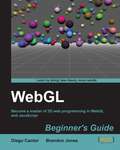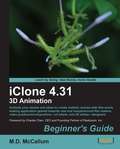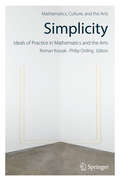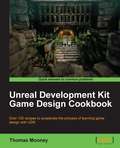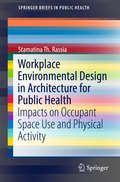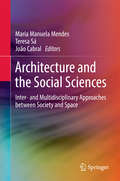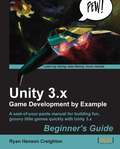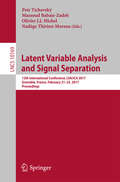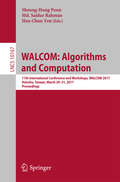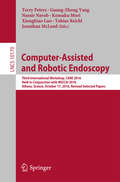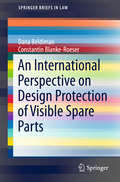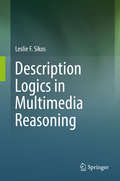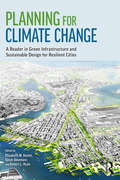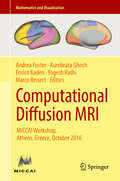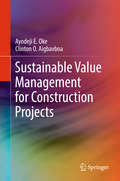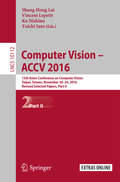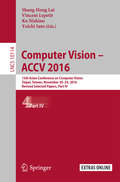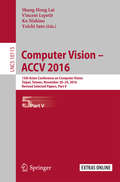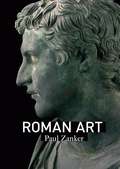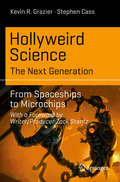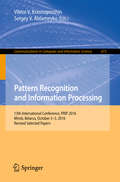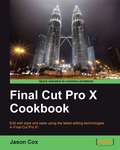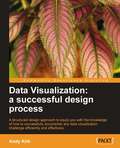- Table View
- List View
WebGL Beginner's Guide
by Diego Cantor Brandon JonesThis book is a step-by-step tutorial that includes complete source code for all of the examples covered. Every chapter builds on top of the previous one thereby giving the reader an immediate feeling of progression. Each block of code is explained, and 3D web development concepts are diagrammed and covered in detail. This book is written for JavaScript developers who are interested in 3D web development. A basic understanding of the DOM object model and the jQuery library is ideal but not required. No prior WebGL knowledge is expected.
iClone 4.31 3D Animation Beginner's Guide
by M. D. McCallumThis book is a part of the Beginner's guide series, wherein you will quickly start doing tasks with precise instructions. Then the tasks will be followed by explanation and then a challenging task or a multiple choice question about the topic just covered. Do you have a story to tell or an idea to illustrate? This book is aimed at film makers, video producers/compositors, vxf artists or 3D artists/designers like you who have no previous experience with iClone. If you have that drive inside you to entertain people via the internet on sites like YouTube or Vimeo, create a superb presentation video, showcase a product or create a movie, or get a fast start on the iClone program, this Beginner's guide was written with you in mind.
Simplicity: Ideals of Practice in Mathematics and the Arts (Mathematics, Culture, and the Arts)
by Roman Kossak Philip OrdingTo find "criteria of simplicity" was the goal of David Hilbert's recently discovered twenty-fourth problem on his renowned list of open problems given at the 1900 International Congress of Mathematicians in Paris. At the same time, simplicity and economy of means are powerful impulses in the creation of artworks. This was an inspiration for a conference, titled the same as this volume, that took place at the Graduate Center of the City University of New York in April of 2013. This volume includes selected lectures presented at the conference, and additional contributions offering diverse perspectives from art and architecture, the philosophy and history of mathematics, and current mathematical practice.
Unreal Development Kit Game Design Cookbook
by Thomas MooneyWritten in cookbook style, this book offers many recipes to learn game design with UDK. Each recipe contains step-by-step instructions followed by analysis of what was done in each task and other useful information. The book is designed so that you can read it chapter by chapter, or you can look at the list of recipes and refer to them in no particular order. This book is meant for game artists who are getting used to UDK but may feel the need for guidance on matters of implementation. It also targets brave beginners who are struggling to find an all in one package for getting started with UDK, and want a ready to hand reference. Level designers can use this book to gauge their understanding of the editor, check for specific problems, and discover gems they may not have come across before.
Workplace Environmental Design in Architecture for Public Health: Impacts on Occupant Space Use and Physical Activity (SpringerBriefs in Public Health)
by Stamatina Th. RassiaThis concise volume analyzes the potential for the workplace environment—where so many people spend so much of their day—to improve workers’ capacity for health and wellness. It pinpoints the link between sedentary lifestyles and poor health, and explores the role of office spatial design in encouraging physical activity to promote physical activity, health and prevent disease. The featured research study tracks workers’ movement in a variety of office layouts, addressing possible ways movement-friendly design can co-exist with wireless communication, paperless offices, and new corporate concepts of productivity. From these findings, the author’s conclusions extend public health concepts to recognize that influencing population-wide levels of activity through office architectural design alone may be possible. This SpringerBrief is comprised of chapters on : Physical activity and disease: Theory and practice Space-use and the history of the office building Identifying factors of the office architectural design that influence movement, Interdisciplinary research methods in studying worker physical activity, decision-making and office design characteristics The KINESIS model for simulating physical activity in office environmentsThe questions and potential for solutions in Workplace Environmental Design in Architecture for Public Health will interest and inform researchers in interdisciplinary topics of public health and architecture as well as graduate and post-graduate students, architects, economists, managers, businesses as well as health-conscious readers.
Architecture and the Social Sciences: Inter- and Multidisciplinary Approaches between Society and Space
by Maria Manuela Mendes Teresa Sá João CabralThis book contributes to current debates on the relationship between architecture and the social sciences, highlighting current interdisciplinary and transdisciplinary teaching as well as research and practice in architecture and urbanism. It also raises awareness about the complementarities and tensions between the spaces of the project, including the construction spaces and living space. It gives voice to recent projects and socio-territorial interventions, focusing on interdisciplinary and multidisciplinary approaches between society and space. Divided into two parts, the first part discusses the possible dialogue between social sciences and architecture, while the second part explores architecture, politics and social change in urban territories from a European perspective.
Unity 3.x Game Development by Example Beginner's Guide
by Creighton HensonThe book takes a clear, step-by-step approach to building small, simple game projects. It focuses on short, attainable goals so that the reader can finish something, instead of trying to create a complex RPG or open-world game that never sees the light of day. This book encourages readers hungry for knowledge. It does not go into gory detail about how every little knob and dial functions – that's what the software manual is for! Rather, this book is the fastest path from zero to finished game using the Unity game engine. If you've ever wanted to develop games, but have never felt "smart" enough to deal with complex programming, this book is for you. It's also a great kick-start for developers coming from other tools like Flash, Unreal Engine, and Game Maker Pro.
Latent Variable Analysis and Signal Separation: 13th International Conference, LVA/ICA 2017, Grenoble, France, February 21-23, 2017, Proceedings (Lecture Notes in Computer Science #10169)
by Petr Tichavský Massoud Babaie-Zadeh Olivier J.J. Michel Nadège Thirion-MoreauThis book constitutes the proceedings of the 13th International Conference on Latent Variable Analysis and Signal Separation, LVA/ICA 2017, held in Grenoble, France, in Feburary 2017. The 53 papers presented in this volume were carefully reviewed and selected from 60 submissions. They were organized in topical sections named: tensor approaches; from source positions to room properties: learning methods for audio scene geometry estimation; tensors and audio; audio signal processing; theoretical developments; physics and bio signal processing; latent variable analysis in observation sciences; ICA theory and applications; and sparsity-aware signal processing.
'Broadsword Calling Danny Boy': On Where Eagles Dare
by Geoff DyerFrom the acclaimed writer and critic Geoff Dyer, an extremely funny scene-by-scene analysis of Where Eagles Dare - published as the film reaches its 50th anniversaryA thrilling Alpine adventure starring a magnificent, bleary-eyed Richard Burton and a coolly anachronistic Clint Eastwood, Where Eagles Dare is the apex of 1960s war movies, by turns enjoyable and preposterous. 'Broadsword Calling Danny Boy' is Geoff Dyer's tribute to the film he has loved since childhood: an analysis taking us from its snowy, Teutonic opening credits to its vertigo-inducing climax. For those who have not even seen Where Eagles Dare, this book is a comic tour-de-force of criticism. But for the film's legions of fans, whose hearts will always belong to Ron Goodwin's theme tune, it will be the fulfilment of a dream.'Geoff Dyer's funniest book yet. Who else would work in Martha Gellhorn on the first page of a book on the film Where Eagles Dare?' Michael Ondaatje'One of our greatest living critics, not of the arts but of life itself, and one of our most original writers' Kathryn Schulz, New York Magazine
Our Journey
by Rak-SuRAK-WHAT? RAK-SU!___________Rak-Pack! Are you ready for our official story?As long as we've been friends, we've been creating our unique sound of soul, R'n'B, Hip-Hop, Latin and Caribbean music.Keeping the momentum going from our X-Factor journey, we are now performing at sold-out arenas, making more music and having fun!So why not join us on the adventure? Unrivalled access to never-before-seen photos, intimate stories, and behind-the-scenes info - in our first and only memoir!_________Ashley, Jamaal, Myles and Mustafa shot to stardom in 2017 as the first ever male group to win the X-Factor. Since then, the soulful boys have been topping the charts with their eclectic sound, performing at sold-out arenas, touring with global sensation Little Mix, recording their first album and most recently dropping their brand new hit single, Pyro Ting.Join Rak-Su on their journey from ordinary North-West London lads, to victors of one of the world's biggest talent shows in their one and ONLY! OFFICIAL memoir, Our Journey.
WALCOM: 11th International Conference and Workshops, WALCOM 2017, Hsinchu, Taiwan, March 29–31, 2017, Proceedings (Lecture Notes in Computer Science #10167)
by Sheung-Hung Poon Md. Saidur Rahman Hsu-Chun YenThis book constitutes the proceedings of the 11th International Workshop on Algorithms and Computation, WALCOM 2017, held in Hsinchu, Taiwan, in March 2017. The 35 full papers presented together with three invited talks were carefully reviewed and selected from 83 submissions. The papers are organized in topical sections on invited talks; computational geometry; combinatorial optimization; graph drawing; graph algorithms; space-efficient algorithms; computational complexity; approximation algorithms.
Computer-Assisted and Robotic Endoscopy: Third International Workshop, CARE 2016, Held in Conjunction with MICCAI 2016, Athens, Greece, October 17, 2016, Revised Selected Papers (Lecture Notes in Computer Science #10170)
by Terry Peters Guang-Zhong Yang Nassir Navab Kensaku Mori Xiongbiao Luo Tobias Reichl Jonathan McLeodThis book constitutes the thoroughly refereed post-conference proceedings of the Third International Workshop on Computer Assisted and Robotic Endoscopy, CARE 2016, held in conjunction with MICCAI 2016, in Athens, Greece, in October 2016. The 11 revised full papers were carefully selected out of 13 initial submissions. The papers are organized on topical secttion such as computer vision, graphics, robotics, medical imaging, external tracking systems, medical device controls systems, information processing techniques, endoscopy planning and simulation.
An International Perspective on Design Protection of Visible Spare Parts (SpringerBriefs in Law)
by Dana Beldiman Constantin Blanke-RoeserThis publication examines the legal aspects of the spare parts market from an IP perspective: specifically whether design protection for spare parts of a complex product extends to the spare part aftermarket, or whether that market should remain open to competition. The stakeholders’ equally weighty arguments that must be balanced against are, on the one hand, the property interest in an earned IP right in the design of the part; and on the other, enhanced competition, likely reflected in lower prices. The mounting tension between these two positions is manifest an increased number of lawsuits in both the US and the EU.This book provides a discussion of the legal issues involved in this debate from a global perspective, with special focus on the EU and the US. Part I contextualizes the legal debate by discussing the historical background, the competitive situation and the respective stakeholder positions. Part II examines the relevant legal questions on a comparative basis, evaluating the likelihood of its adoption in the jurisdictions examined. Concluding that adoption is unlikely, Part III proposes a number of possible considerations meant to further compromise. Part IV concludes with a future outlook, specifically in light of the impact of technological development on this market.
Description Logics in Multimedia Reasoning
by Leslie F. SikosThis book illustrates how to use description logic-based formalisms to their full potential in the creation, indexing, and reuse of multimedia semantics. To do so, it introduces researchers to multimedia semantics by providing an in-depth review of state-of-the-art standards, technologies, ontologies, and software tools. It draws attention to the importance of formal grounding in the knowledge representation of multimedia objects, the potential of multimedia reasoning in intelligent multimedia applications, and presents both theoretical discussions and best practices in multimedia ontology engineering. Readers already familiar with mathematical logic, Internet, and multimedia fundamentals will learn to develop formally grounded multimedia ontologies, and map concept definitions to high-level descriptors. The core reasoning tasks, reasoning algorithms, and industry-leading reasoners are presented, while scene interpretation via reasoning is also demonstrated.Overall, this book offers readers an essential introduction to the formal grounding of web ontologies, as well as a comprehensive collection and review of description logics (DLs) from the perspectives of expressivity and reasoning complexity. It covers best practices for developing multimedia ontologies with formal grounding to guarantee decidability and obtain the desired level of expressivity while maximizing the reasoning potential. The capabilities of such multimedia ontologies are demonstrated by DL implementations with an emphasis on multimedia reasoning applications.
Planning for Climate Change: A Reader in Green Infrastructure and Sustainable Design for Resilient Cities
by Elisabeth M. Hamin Infield Yaser Abunnasr Robert L. RyanThis book provides an overview of the large and interdisciplinary literature on the substance and process of urban climate change planning and design, using the most important articles from the last 15 years to engage readers in understanding problems and finding solutions to this increasingly critical issue. The Reader’s particular focus is how the impacts of climate change can be addressed in urban and suburban environments—what actions can be taken, as well as the need for and the process of climate planning. Both reducing greenhouse gas emissions as well as adapting to future climate are explored. Many of the emerging best practices in this field involve improving the green infrastructure of the city and region—providing better on-site stormwater management, more urban greening to address excess heat, zoning for regional patterns of open space and public transportation corridors, and similar actions. These actions may also improve current public health and livability in cities, bringing benefits now and into the future. This Reader is innovative in bringing climate adaptation and green infrastructure together, encouraging a more hopeful perspective on the great challenge of climate change by exploring both the problems of climate change and local solutions.
Computational Diffusion MRI: MICCAI Workshop, Athens, Greece, October 2016 (Mathematics and Visualization)
by Andrea Fuster Aurobrata Ghosh Enrico Kaden Yogesh Rathi Marco ReisertThis volume offers a valuable starting point for anyone interested in learning computational diffusion MRI and mathematical methods for brain connectivity, while also sharing new perspectives and insights on the latest research challenges for those currently working in the field. Over the last decade, interest in diffusion MRI has virtually exploded. The technique provides unique insights into the microstructure of living tissue and enables in-vivo connectivity mapping of the brain. Computational techniques are key to the continued success and development of diffusion MRI and to its widespread transfer into the clinic, while new processing methods are essential to addressing issues at each stage of the diffusion MRI pipeline: acquisition, reconstruction, modeling and model fitting, image processing, fiber tracking, connectivity mapping, visualization, group studies and inference. These papers from the 2016 MICCAI Workshop “Computational Diffusion MRI” – which was intended to provide a snapshot of the latest developments within the highly active and growing field of diffusion MR – cover a wide range of topics, from fundamental theoretical work on mathematical modeling, to the development and evaluation of robust algorithms and applications in neuroscientific studies and clinical practice. The contributions include rigorous mathematical derivations, a wealth of rich, full-color visualizations, and biologically or clinically relevant results. As such, they will be of interest to researchers and practitioners in the fields of computer science, MR physics, and applied mathematics.
Sustainable Value Management for Construction Projects
by Ayodeji E. Oke Clinton O. AigbavboaThis book provides a unique guide to value management and sustainability in construction to researchers and professional. The book provides a better understanding of the concept of value management, the basis of sustainable construction and thereafter, demonstrates how using the principles of value management can help to achieve successful construction projects that are financially viable, socially beneficial and do not damage the environment.The book serves as an introduction to value management for scholars and researchers at all levels; and also as a practical guide for construction professionals, employers and other stakeholders in the construction industry.
Computer Vision – ACCV 2016: 13th Asian Conference on Computer Vision, Taipei, Taiwan, November 20-24, 2016, Revised Selected Papers, Part II (Lecture Notes in Computer Science #10112)
by Shang-Hong Lai Vincent Lepetit Ko Nishino Yoichi SatoThe five-volume set LNCS 10111-10115 constitutes the thoroughly refereed post-conference proceedings of the 13th Asian Conference on Computer Vision, ACCV 2016, held in Taipei, Taiwan, in November 2016.The total of 143 contributions presented in these volumes was carefully reviewed and selected from 479 submissions. The papers are organized in topical sections on Segmentation and Classification; Segmentation and Semantic Segmentation; Dictionary Learning, Retrieval, and Clustering; Deep Learning; People Tracking and Action Recognition; People and Actions; Faces; Computational Photography; Face and Gestures; Image Alignment; Computational Photography and Image Processing; Language and Video; 3D Computer Vision; Image Attributes, Language, and Recognition; Video Understanding; and 3D Vision.
Computer Vision – ACCV 2016: 13th Asian Conference on Computer Vision, Taipei, Taiwan, November 20-24, 2016, Revised Selected Papers, Part IV (Lecture Notes in Computer Science #10114)
by Shang-Hong Lai Vincent Lepetit Ko Nishino Yoichi SatoThe five-volume set LNCS 10111-10115 constitutes the thoroughly refereed post-conference proceedings of the 13th Asian Conference on Computer Vision, ACCV 2016, held in Taipei, Taiwan, in November 2016.The total of 143 contributions presented in these volumes was carefully reviewed and selected from 479 submissions. The papers are organized in topical sections on Segmentation and Classification; Segmentation and Semantic Segmentation; Dictionary Learning, Retrieval, and Clustering; Deep Learning; People Tracking and Action Recognition; People and Actions; Faces; Computational Photography; Face and Gestures; Image Alignment; Computational Photography and Image Processing; Language and Video; 3D Computer Vision; Image Attributes, Language, and Recognition; Video Understanding; and 3D Vision.
Computer Vision – ACCV 2016: 13th Asian Conference on Computer Vision, Taipei, Taiwan, November 20-24, 2016, Revised Selected Papers, Part V (Lecture Notes in Computer Science #10115)
by Shang-Hong Lai Vincent Lepetit Ko Nishino Yoichi SatoThe five-volume set LNCS 10111-10115 constitutes the thoroughly refereed post-conference proceedings of the 13th Asian Conference on Computer Vision, ACCV 2016, held in Taipei, Taiwan, in November 2016.The total of 143 contributions presented in these volumes was carefully reviewed and selected from 479 submissions. The papers are organized in topical sections on Segmentation and Classification; Segmentation and Semantic Segmentation; Dictionary Learning, Retrieval, and Clustering; Deep Learning; People Tracking and Action Recognition; People and Actions; Faces; Computational Photography; Face and Gestures; Image Alignment; Computational Photography and Image Processing; Language and Video; 3D Computer Vision; Image Attributes, Language, and Recognition; Video Understanding; and 3D Vision.
Roman Art (PDF)
by Paul ZankerTraditional studies of Roman art have sought to identify an indigenous style distinct from Greek art and in the process have neglected the large body of Roman work that creatively recycled Greek artworks. Now available in paperback, this fresh reassessment offers instead a cultural history of the functions of the visual arts, the messages that these images carried, and the values that they affirmed in late Republican Rome and the Empire. The analysis begins at the point at which the characteristic features of Roman art started to emerge, when the Romans were exposed to Hellenistic culture through their conquest of Greek lands in the third century B.C. As a result, the values and social and political structure of Roman society changed, as did the functions and character of the images it generated. This volume, presented in very clear and accessible language, offers new and fascinating insights into the evolution of the forms and meanings of Roman art.
Hollyweird Science: From Spaceships to Microchips (Science and Fiction)
by Kevin R. Grazier Stephen CassInformative, entertaining and upbeat, this book continues Grazier and Cass's exploration of how technology, science, and scientists are portrayed in Hollywood productions. Both big and small-screen productions are featured and their science content illuminated—first by the authors and subsequently by a range of experts from science and the film world. Starring roles in this volume are played by, among other things, computers (human and mechanical), artificial intelligences, robots, and spacecraft. Interviews with writers, producers, and directors of acclaimed science-themed films stand side by side with the perspectives of scientists, science fiction authors, and science advisors. The result is a stimulating and informative reading experience for the layperson and professional scientist or engineer alike. The book begins with a foreword by Zack Stentz, who co-wrote X-Men: First Class and Thor, and is currently a writer/producer on CW’s The Flash.
Pattern Recognition and Information Processing: 13th International Conference, PRIP 2016, Minsk, Belarus, October 3-5, 2016, Revised Selected Papers (Communications in Computer and Information Science #673)
by Viktor V. Krasnoproshin Sergey V. AblameykoThis book constitutes the refereed proceedings of the 13th International Conference on Pattern Recognition and Information Processing, PRIP 2016, held in Minsk, Belarus, in October 2016. The 18 revised full papers presented were carefully reviewed and selected from 72 submissions. The papers are organized in topical sections on summarizing lectures; pattern recognition and image analysis; information processing and applications.
Final Cut Pro X Cookbook
by Jason CoxWritten in cookbook style, this book offers many recipes to edit slick, professional videos with FCPX. Each recipe contains step-by-step instructions followed by analysis of what was done in each task and other useful information. The book is designed so that you can read it chapter by chapter, or you can look at the list of recipes and refer to them in no particular order. If you've been toying around with iMovie and want more power or you've taken FCPX for a whirl and simply can't find the fastest, most efficient workflow, this book will help! Veteran editors will find just as much useful info as FCPX is radically different than its predecessor, Final Cut Pro 7.
Data Visualization: a successful design process
by Andy KirkA comprehensive yet quick guide to the best approaches to designing data visualizations, with real examples and illustrative diagrams. Whatever the desired outcome ensure success by following this expert design process. This book is for anyone who has responsibility for, or is interested in trying to find innovative and effective ways to visually analyze and communicate data. There is no skill, no knowledge and no role-based pre-requisites or expectations of anyone reading this book.
